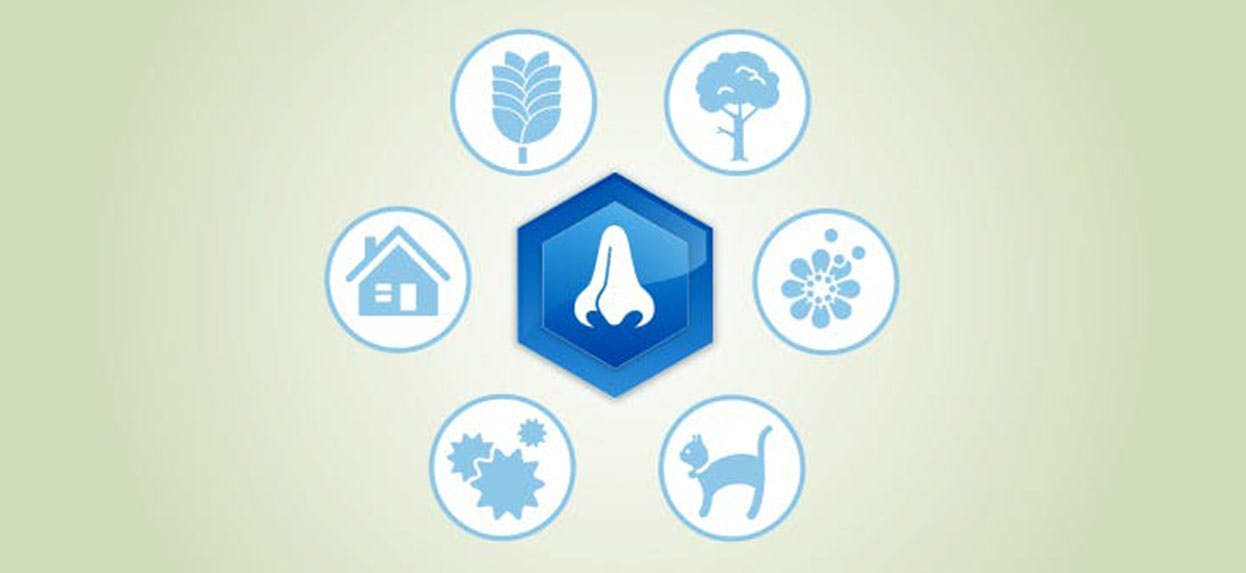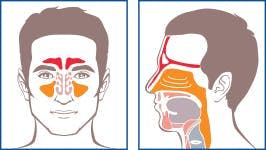
ALLERGY
TIPS
WHAT’S THE DIFFERENCE BETWEEN ALLERGIES AND SINUSITIS?

When you suffer from allergies, or allergic rhinitis, you may experience a lot of uncomfortable nasal symptoms. But how can you tell if your symptoms are just your allergies acting up, or something more serious like sinusitis (also known as sinus infection)?
When you feel under the weather, it can be difficult to pinpoint the culprit behind your nasty nasal symptoms. This article can help by breaking down the key differences between allergies and a sinus infection.
ALLERGIC |
SINUSITIS |
|
What is it? |
Inflammation in the nose. |
Inflammation of the sinuses. Your sinuses are located in the the forehead, cheekbones, and behind the nose. |
What causes it? |
Indoor and outdoor allergens such as pollen, mould, dust, and pet dander. |
Sinus infection is usually caused by a virus or bacteria. But it can also be caused by nasal polyps or a deviated nasal septum. |
What are common symptoms? |
Common symptoms of allergic rhinitis include sneezing, runny nose, nasal congestion, itchy nose, and itchy, watery eyes. Your nose may produce a thick, pale yellow mucus. In addition, some people may also experience sinus pain and pressure. |
Thick yellow or greenish mucus, frontal headaches, sinus pressure (tenderness and swelling around the eyes, cheeks, nose and forehead), fever, bad breath, and reduced sense of smell and taste*. |
What should I do? |
You may want to talk to an allergist to identify the causes of your allergy symptoms, so you can avoid them when possible. Taking the right allergy medicine as soon as your symptoms start can help alleviate symptoms. |
If you think you may have sinusitis, see your doctor for diagnosis and an appropriate treatment plan. |
ALLERGIC |
What is it? |
Inflammation in the nose. |
What causes it? |
Indoor and outdoor allergens such as pollen, mould, dust, and pet dander. |
What are the symptoms? |
Common symptoms of allergic rhinitis include sneezing, runny nose, nasal congestion, itchy nose, and itchy, watery eyes. Your nose may produce a thick, pale yellow mucus. In addition, some people may also experience sinus pain and pressure. |
What should I do? |
You may want to talk to an allergist to identify the causes of your allergy symptoms, so you can avoid them when possible. Taking the right allergy medicine as soon as your symptoms start can help alleviate symptoms. |
SINUSITIS |
What is it? |
Inflammation of the sinuses. Your sinuses are located in the the forehead, cheekbones, and behind the nose. |
What causes it? |
Sinus infection is usually caused by a virus or bacteria. But it can also be caused by nasal polyps or a deviated nasal septum. |
What are the symptoms? |
Thick yellow or greenish mucus, frontal headaches, sinus pressure (tenderness and swelling around the eyes, cheeks, nose and forehead), fever, bad breath, and reduced sense of smell and taste*. |
What should I do? |
If you think you may have sinusitis, see your doctor for diagnosis and an appropriate treatment plan. |
What are sinuses anyway?
Your skull has four pairs of sinuses, or hollow spaces, called the paranasal sinuses. Your sinuses are lined with the same kind of tissue that lines the inside of your nose.
Did you know your sinuses have some pretty impressive functions? They help lighten the skull, warm and humidify the air you inhale, and give resonance to your voice. They even add shape to your face!

*FLONASE Allergy Relief is not indicated to treat these symptoms.
